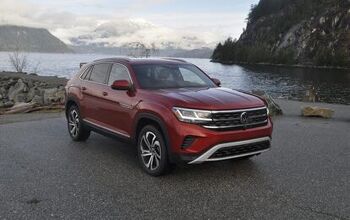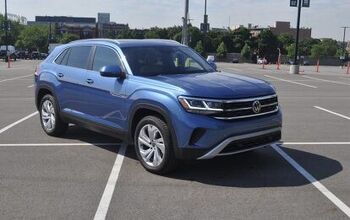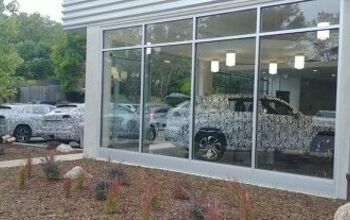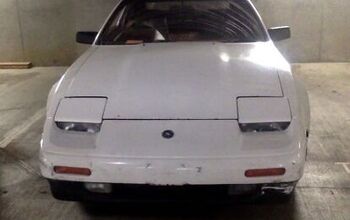2020 Volkswagen Atlas Cross Sport: More of a Good Thing

Readers might not nod their heads in agreement after seeing this headline, knowing full well it denotes the appearance of another crossover on the avenues and byways of America, but Volkswagen would respectfully disagree. For the automaker’s American arm, it most definitely is a good thing.
Eager to make new friends following the brand’s disastrous diesel affair, Volkswagen changed course, pledging to give Americans more of what they claim they want. And it seems the effort paid off. Arriving at dealers in May of 2017, the mid-size, made-in-America Atlas crossover has proven a sales coup. Through September, more than one-fifth (21.5 percent) of Volkswagens sold in the U.S. in 2019 bore the Atlas name. Volume is up 39 percent, year to date.
If having one Atlas is a good thing, surely having two is better? From a sales and revenue perspective, Volkswagen certainly hopes so.
(Full disclosure: Volkswagen flew me to Chattanooga, Tennessee for the unveiling of the new Atlas Cross Sport, set me up in a nice hotel, and provided buffet-style meals for attendees. No swag was offered or accepted, minus a cheap pen I used to take notes. Only tap water, and a quite fine tap water at that, was consumed in the hotel room.)
The Atlas Cross Sport revealed today at VW’s Chattanooga assembly plant takes the existing crossover and wraps it up in a just-different-enough package. Wheelbase remains the same, as do powertrains, but the body and interior see key alterations.
This vehicle seats no more than five. While the Atlas continues on as VW’s three-row family hauler extraordinaire, the Atlas Cross Sport is aimed at capturing buyers whose kids have yet to arrive — or perhaps they’ve just left. Removing the rear chairs allowed VW to adopt a rakish angle to the rear glass while lowering the model’s height by 2.3 inches. There’ll be no headroom complaints from the rearmost passengers in this ride. Behind them sits a competitive 40.3 cubic feet of rear cargo volume.
All of that height reduction stems from a roofline haircut, not a suspension drop. The automaker didn’t tinker with underbody bits in creating its newest model; ground clearance remains the same as the Atlas. Length is nearly the same, too, with the Cross Sport stretching just 2.8 inches shy of its (slightly) larger sibling. As best as any VW of America exec can guess, the model shaves about 150 pounds from the three-row’s curb weight.
Why build the Atlas Cross Sport? The answers are numerous: Blazer, Edge, Passport, Grand Cherokee, and the list goes on. As an ebullient Scott Keogh, CEO of Volkswagen Group of America, stated at Friday’s reveal, some 45 percent of the mid-size utility vehicle segment is made up of two-row vehicles, and VW wants a slice of the action.
“As a businessman, there’s no way I want to miss 45 percent of the market,” Keogh said.
The addition of the Atlas to VW’s stable increased the average transaction price of a new Veedub by nearly four grand, he said. Spawning a new, slightly higher-priced Atlas variant would only serve to fill company coffers at an accelerated rate.
What’ll it cost? The company won’t say, though Keogh promised “competitive” pricing in an area VW belongs. To him, that means the $30k range. From what TTAC could gather from company brass, the markup shouldn’t be more than $2,000. The 2019 Atlas starts at $31,890 after destination; V6 models start at $35,090.
Arriving at dealers in the first quarter of 2020, the Atlas Cross Sport dons a revised grille and lower fascia, front and rear, to further differentiate itself from its three-row brother. Seen here in top-spec SEL V6 R-Line trim, the Cross Sport offers revamped headlamps featuring a new LED running lamp pattern, a deeper grille with three chrome crossbars (not the Atlas’ two), and larger, chrome-ringed side scoops down below. The lower air opening also lacks an intruding body-color strip. Out back, the taillamps are slimmer, creating a gap between them and the chrome trim strip that spans the liftgate. Coupled with the reduced roof height and sloped rear glass, the cosmetic changes make the Cross Sport appear wider and more athletic than a stock Atlas.
Sadly, the Atlas’ fake exhaust ports have grown both in size and prominence. Real ports would’ve been a welcome deviation here. Oh well. If you’re wondering, those 21-inch wheels are of a design exclusive to the Cross Sport; you’ll need to tick the R-Line appearance package box to bring them on board, and VW plans to make it very easy to do so. Only the base S eschews the R-Line option.
Inside you’ll find no dramatic departures aside from the missing rear seats, though eagle-eyed observers will notice a completely new steering wheel. Model-exclusive interior trim options will be on offer, along with loads of tech goodies for higher-end buyers — among them, the Volkswagen Digital Cockpit instrument display and an updated Volkswagen Car-Net connectivity suite that allows four users to tap into the internet at the same time. Traffic Jam Assist and Dynamic Road Sign Display are also new to the VW herd, appearing here to help drivers navigate their congested lives.
While all Atlases make do with an eight-speed automatic, there’s more four-cylinder choice to be had with the Cross Sport. VW’s turbocharged 2.0-liter, good for 235 horsepower and 258 lb-ft of torque, can be combined with 4Motion all-wheel drive. It’s also offered on all but the top-flight SEL Premium trim. The Atlas only offers a four-banger in its low-end, front-drive offering.
“With 4Motion, it will increase the attractiveness of that vehicle,” said Hein Schafter, VW of America’s senior vice president of product marketing and strategy. Estimating the take rate of the Atlas 2.0L at five to 10 percent of sales, Schafer predicts a greater draw for the four-cylinder Cross Sport. “We’re working on getting it into the top trim,” he added.
The company’s 3.6-liter V6, generating 276 hp and 235 lb-ft, will be on hand for those wanting extra grunt and a 5,000-pound towing capacity.
When asked if VW considered building something a little wilder than what the company revealed on Friday, Schafer and newly minted VW of America Chief Operating Officer Johan de Nysschen claimed the Cross Sport made the most sense in its present form. Given the financial necessity of maintaining a strong commonality between the two Atlas models, VW was left with “a narrow envelope to create differentiation,” de Nysschen said.
“I think the car has a distinct persona,” he added. “It will appeal to a different demographic.”
As for projected sales, Schafer feels that the Cross Sport might see volumes of roughly 50 percent of Atlas sales. This jibes with what VW Chattanooga CEO Tom du Plessis told TTAC. His guesstimate placed combined Atlas volume at 140,000 vehicles per year. With the still-growing Atlas on track to sell roughly 80,000 units in 2019, and with a refresh inbound for Q2 2020, volume could easily reach higher in the coming year. A two-to-one Atlas/Cross Sport volume ratio would put total sales around that number.
It would also make the Atlas nameplate account for nearly a third of all VW sales in the United States. Higher volumes of a higher-margin vehicle is just what the automaker needs to help it with its next challenge: Building and selling electric vehicles to a hesitant U.S. public. A production version of the upcoming I.D. Crozz electric crossover, slated for production in Chattanooga, is expected to appear within a year.
[Images: Steph Willems/TTAC]

More by Steph Willems
Latest Car Reviews
Read moreLatest Product Reviews
Read moreRecent Comments
- Jrhurren Legend
- Ltcmgm78 Imagine the feeling of fulfillment he must have when he looks upon all the improvements to the Corvette over time!
- ToolGuy "The car is the eye in my head and I have never spared money on it, no less, it is not new and is over 30 years old."• Translation please?(Theories: written by AI; written by an engineer lol)
- Ltcmgm78 It depends on whether or not the union is a help or a hindrance to the manufacturer and workers. A union isn't needed if the manufacturer takes care of its workers.
- Honda1 Unions were needed back in the early days, not needed know. There are plenty of rules and regulations and government agencies that keep companies in line. It's just a money grad and nothing more. Fain is a punk!









































Comments
Join the conversation
Doesn't the Atlas have the worst driving range in its class? Small gas tank plus poor mileage equals terrible range. I assume this is more of the same.
It's definitely more of a thing. More vehicle and yet another edition to the big CUV pool.